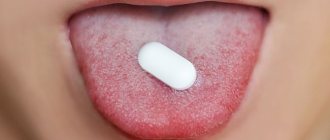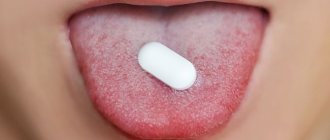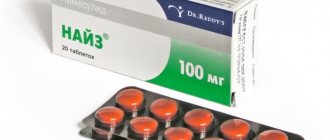Ibuprofen
The simultaneous use of ibuprofen with the following drugs should be avoided:
- Acetylsalicylic acid: with the exception of low doses of acetylsalicylic acid (no more than 75 mg per day) prescribed by a doctor, since combined use may increase the risk of side effects. With simultaneous use, ibuprofen reduces the anti-inflammatory and antiplatelet effect of acetylsalicylic acid (an increase in the incidence of acute coronary insufficiency in patients receiving small doses of acetylsalicylic acid as an antiplatelet agent is possible after starting ibuprofen).
- Other NSAIDs, in particular selective COX-2 inhibitors: simultaneous use of two or more drugs from the NSAID group should be avoided due to a possible increased risk of side effects.
Use with caution simultaneously with the following medications:
- Anticoagulants and thrombolytic drugs: NSAIDs may enhance the effect of anticoagulants, in particular warfarin and thrombolytic drugs.
- Antihypertensive drugs (ACE inhibitors and angiotensin II antagonists) and diuretics: NSAIDs may reduce the effectiveness of drugs in these groups. In some patients with impaired renal function (eg, dehydrated patients or elderly patients with impaired renal function), coadministration of ACE inhibitors or angiotensin II antagonists and cyclooxygenase inhibitors may lead to a deterioration of renal function, including the development of acute renal failure. (usually reversible). These interactions should be considered in patients taking coxibs concomitantly with ACE inhibitors or angiotensin II antagonists. In this regard, the combined use of the above drugs should be prescribed with caution, especially in the elderly. Patients should be prevented from dehydration and consideration should be given to monitoring renal function upon initiation of this combination treatment and periodically thereafter.
Diuretics and ACE inhibitors may increase the nephrotoxicity of NSAIDs.
- Glucocorticosteroids: increased risk of gastrointestinal ulcers and gastrointestinal bleeding.
- Antiplatelet agents and selective serotonin reuptake inhibitors: increased risk of gastrointestinal bleeding.
- Cardiac glycosides: simultaneous administration of NSAIDs and cardiac glycosides can lead to worsening heart failure, a decrease in glomerular filtration rate and an increase in the concentration of cardiac glycosides in the blood plasma.
— Lithium preparations: there is evidence of the likelihood of an increase in the concentration of lithium in the blood plasma during the use of NSAIDs.
- Methotrexate: there is evidence of the likelihood of an increase in the concentration of methotrexate in the blood plasma during the use of NSAIDs.
- Cyclosporine: increased risk of nephrotoxicity with simultaneous administration of NSAIDs and cyclosporine.
- Mifepristone: NSAIDs should be started no earlier than 8-12 days after taking mifepristone, as NSAIDs may reduce the effectiveness of mifepristone.
- Tacrolimus: when NSAIDs and tacrolimus are co-administered, the risk of nephrotoxicity may increase.
— Zidovudine: simultaneous use of NSAIDs and zidovudine may lead to increased hematotoxicity. There is evidence of an increased risk of hemarthrosis and hematomas in HIV-positive patients with hemophilia who received concomitant treatment with zidovudine and ibuprofen.
- Quinolone antibiotics: in patients receiving concomitant treatment with NSAIDs and quinolone antibiotics, the risk of seizures may increase.
— Myelotoxic drugs: increased hematotoxicity.
— Cefamandole, cefoperazone, cefotetan, valproic acid, plicamycin: increased incidence of hypoprothrombinemia.
- Drugs that block tubular secretion: decreased excretion and increased plasma concentrations of ibuprofen.
— Inducers of microsomal oxidation (phenytoin, ethanol, barbiturates, rifampicin, phenylbutazone, tricyclic antidepressants): increased production of hydroxylated active metabolites, increased risk of developing severe intoxications.
Microsomal oxidation inhibitors: reducing the risk of hepatotoxicity.
— Oral hypoglycemic drugs and insulin, sulfonylurea derivatives: increased effect of drugs.
- Antacids and cholestyramine: decreased absorption.
— Uricosuric drugs: decreased effectiveness of drugs.
— Caffeine: increased analgesic effect.
Pain in the lower abdomen in women in questions and answers
Pain in the lower abdomen
is the most common complaint in gynecological practice.
This symptom is very non-specific, as it occurs in many diseases. Today, many people have non-steroidal anti-inflammatory drugs (NSAIDs) in their medicine cabinet. The choice is wide, and the doctor and pharmacist must orient the woman in the possibilities of certain drugs and warn her, reminding her of the importance of a timely visit to the doctor, as well as answer all questions. Complaint: pain during menstruation
How it begins: 1) One day before or on the 1st day of the menstrual cycle.
Continues during the first 2-42 hours or throughout the entire menstruation. 2) In the 2nd half of the cycle, it reaches its peak during menstruation. 3) During menstruation. How does it hurt?
The pain is often cramping in nature, but can be aching, tugging, bursting, and can radiate to the rectum.
Severe, often spasmodic pain. What else is worrying?
1) Irritability, depression, nausea, chills, dizziness, fainting, headache, swelling (possible dysmenorrhea).
2) Pain during sexual intercourse, periodic pain during urination, defecation (possible endometriosis). 3) Prolonged or too intense menstrual bleeding. Sometimes bleeding outside of menstruation. There may be an increase in the volume of the abdomen and a frequent urge to urinate (possible uterine fibroids).
Caution: acute pain
Acute intense and/or unilateral pain in the lower abdomen may indicate a gynecological emergency: - perforation or rupture of tumors and tumor-like formations of the ovaries;
- torsion of the anatomical pedicles of the ovary; - ovarian apoplexy; - intra-abdominal bleeding; - acute purulent diseases of the pelvic organs, etc., so consultation with a doctor is necessary. What can hurt?
The causes of pain in the lower abdomen can be very different: pathologies of the development of the genital organs, purulent-inflammatory diseases of the uterine appendages, endometriosis, diseases of the gastrointestinal tract (GIT) and urinary system. One of the most common causes of periodic lower abdominal pain in women is dysmenorrhea. Cyclic pain in the lower abdomen can be caused by endometriosis, polycystic ovary syndrome, sexually transmitted infections, and other serious diseases. Such dysmenorrhea is considered secondary, and treatment of the disease that caused it, as a rule, leads to complete recovery. Primary dysmenorrhea is characterized by the appearance of cyclic pain in the lower abdomen several hours before menstruation and in the first days of the menstrual cycle in the absence of any pathology from the pelvic organs. Primary dysmenorrhea most often occurs in young women.
Pain with dysmenorrhea:
- Reaches maximum intensity at the peak of bleeding. - It can be sharp, cramping, bursting or dull. - Most often it is localized in the midline in the suprapubic region, but may not be clearly localized. - May radiate to the lumbar region, rectum or thigh.
Or maybe it’s worth enduring the pain?
The multifaceted influence of pain syndrome on the human body determines its independent clinical significance.
Pain not only determines the severity of suffering and social maladjustment of the patient, but is also fraught with more serious consequences, for example, disruption of the normal function of organs, especially the cardiovascular system. Enduring pain is not recommended. What medicine will help?
The first stage of rational analgesic therapy is the elimination of the effect of the damaging factor (if possible), as well as the suppression of the body’s local response to damage.
For these purposes, drugs are used that block the synthesis of mediators of pain and inflammation. The main mediators of inflammation - prostaglandins (PG) - are actively synthesized in the area of damage with the participation of the enzyme cyclooxygenase (COX). It is important that the causes of damage (trauma, surgery, inflammation, swelling or ischemia of tissue, persistent spasm of striated or smooth muscles, etc.) do not matter, therefore the use of drugs that block COX and suppress the synthesis of pro-inflammatory PGs will help with any somatic or visceral pain. Well-known NSAIDs have this effect. In the case of dysmenorrhea, one of the main pathogenetic mechanisms is a high level of PG. An increase in their ratio in the menstrual endometrium leads to a contraction of the muscular elements of the uterus. PGs are secreted in almost all tissues of the genital organs: endometrium, myometrium, endothelium of uterine vessels, tubes, etc. An increase in their level leads to increased contractility of the uterus, against which vascular spasm and local ischemia occur, which manifests itself as pain. Moreover, the high level of PG detected during dysmenorrhea causes ischemia of other organs and tissues, which results in symptoms of dysmenorrhea such as headaches, dizziness, weakness, etc. In the treatment of primary dysmenorrhea, NSAIDs are one of the drugs of choice. Which is better, NSAIDs or antispasmodics?
The previously stated assumption about the comparable effectiveness of antispasmodics and NSAIDs in the treatment of primary dysmenorrhea has not found experimental confirmation.
In particular, antispasmodics were inferior to NSAIDs in terms of pain relief. Currently, antispasmodics are not included in the international standards for the treatment of primary dysmenorrhea. Thus, NSAIDs are recognized as the most effective drugs in the treatment of this pathology. Among the drugs widely used for dysmenorrhea, the most common are NSAIDs with a short half-life (dexketoprofen, ketoprofen, nimesupid, diclofenac, ibuprofen, indomethacin, etc.).
Which NSAIDs are the most effective?
There is no ideal NSAID, so an individual approach is required in each specific clinical situation.
On average, the therapeutic effect of different NSAIDs is the same with the appropriate dosage regimen. However, some studies have noted significant differences in individual response between individual patients. Thus, it is impossible to predict which NSAID will be most effective in a particular patient. NSAIDs are available in different dosage forms (tablets, suppositories, injections), which allows you to choose the form that is most suitable for a specific clinical situation. How to take NSAIDs for dysmenorrhea?
For dysmenorrhea, NSAIDs should be taken before the onset of symptoms or at the first manifestations (in the first 48-72 hours) due to the maximum release of PG in the first 48 hours. Short-term use of NSAIDs for dysmenorrhea has virtually no side effects or they are only slightly expressed.
Irritation of the gastrointestinal mucosa can be easily prevented by taking NSAIDs after meals or milk. Important!
Patients should not take NSAIDs: - with erosive and ulcerative lesions of the gastrointestinal tract, especially in the acute stage;
- with severe impairment of liver and kidney function; - with cytopenias; - in case of individual intolerance; - during pregnancy. Basic rules for the use of NSAIDs:
- use of the minimum effective dose for the shortest possible period of time necessary to achieve the therapeutic goal. - if there is no effect within 3 days of use, consult a doctor. Uncontrolled and long-term use of NSAIDs is unacceptable.
First aid for dysmenorrhea will be provided by the so-called “gold standard” NSAID - ibuprofen, and its capsule form is
IBUPROFEN CAPS
. Why in capsules?
The answer is simple. IBUPROFEN CAPS
is the “second modern generation” of ibuprofen in 200 mg capsules with the onset of the therapeutic effect within 15 minutes.
The advantage of IBUPROFEN CAPS
is the rapid onset of action.
And we need to quickly eliminate the pain. In addition, the capsules hide the unpleasant taste and ensure dosing accuracy. When taken orally, IBUPROFEN CAPS
, produced by
Minskintercaps
, quickly disintegrates and dissolves, achieving the maximum therapeutic effect within 45-60 minutes.
Another criterion based on which IBUPROFEN CAPS
is the presence of a number of clinical studies in Belarus and Russia, where the drug
IBUPROFEN CAPS
confirmed its biological equivalence to the original drug Nurofen ultracap.
Adults and children over 12 years of age can take Ibuprofen CAPS
to relieve pain, 1 or 2 capsules up to three times a day, keeping an interval of at least four hours between doses.
IBUPROFEN CAPS
is a modern, ultra-fast-acting form of ibuprofen.
based on materials from the magazine “Pharmacist’s Handbook”, No. 2, 2017
26 Jun 2019
Previous News Feed Next
Instructions for taking Ibuprofen for adults and children.
- A single dosage for an adult is 200 mg; in case of severe pain, you can take 400 mg, the dosage frequency is 3-4 times a day, but not more than 1200 mg per day.
- A single dose for a child over 6 years old is 200 mg, can be taken 3-4 times a day. The maximum dosage for children per day differs by age as follows: for children 12-17 years old - 1000 mg; for children aged 6 to 12 years - 800 mg.
Ibuprofen Welfarm for adults
How many days can you take Ibuprofen?
The drug is taken for 2-3 days; if the patient’s condition does not improve or becomes worse, it is necessary to stop taking it and consult a doctor.
Indications for use
Ibuprofen belongs to the group of non-steroidal anti-inflammatory drugs (NSAIDs) - derivatives of phenylpropionic acid. In the instructions for tablets and capsules for adults, we see primarily prescriptions related to the symptomatic treatment of diseases of the joints or spine (rheumatoid arthritis, osteoarthritis, bursitis, sciatica), the fight against pain from injuries, myalgia and neuritis. In children's forms, we find the following indications: sore throat, pain with otitis media, teething, reduction of fever during ARVI or influenza, relief of symptoms of fever during childhood infections and post-vaccination reactions.
Of course, the indications are not limited to those mentioned above. We list here the most common types of pathologies where Ibuprofen does an excellent job eliminating inflammation and pain:
- Pathologies of the musculoskeletal system, pain relief: ankylosing spondylitis, radiculitis, spinal osteochondrosis, exacerbation of gout, polyarthrosis, psoriatic arthritis, tendinitis, inflammation of soft tissues in injuries, back pain, joint pain, trauma, sprains, dislocations, myalgia of various types .
- Diseases of the peripheral nervous system: neuralgia and neuritis.
- Gynecology: primary dysmenorrhea, secondary dysmenorrhea, pain during painful menstruation, with adnexitis.
- Relief of various types of pain: toothache, headache, migraine, sore throat, ear pain with otitis media, muscle pain.
- Use as an antipyretic for fever, flu, ARVI and colds. Increased temperature in infectious and inflammatory diseases.
- Relief after vaccination, including against coronavirus.
Contraindications:
- Hypersensitivity to the components of the drug.
- Bleeding disorders, hemophilia.
- Hematopoietic disorders.
- Erosive and ulcerative lesions of the gastrointestinal tract in the acute stage, bleeding in the gastrointestinal tract.
- Kidney or liver failure.
- Severe heart failure.
- The period after coronary artery bypass surgery.
- “Aspirin triad” (aspirin intolerance, nasal polyps and bronchial asthma).
- Diseases of the optic nerve.
- Caution should be exercised when taking other NSAIDs.
- Simultaneous use of medication and alcoholic beverages is not recommended.
What forms does Ibuprofen come in?
In pharmacies you can find four dosage forms of the drug:
- If there are no contraindications related to the gastrointestinal tract, then people usually choose tablets or capsules.
- In cases where there is a stomach disease in the acute stage or the patient for some reason cannot swallow a tablet, suppositories are prescribed.
- Syrups are prescribed to infants. Most pediatricians prefer to reduce fever using Ibuprofen rather than Paracetamol, since the former acts faster and longer, and also has a lower safety profile due to the absence of toxic metabolites.
- For pain in the joints, muscles, back, and injuries, the ointment is ideal.
Ibuprofen ointment 5%
The drug is widely used as an external agent. Ointments and gels are produced in pure form or with the addition of cooling agents.
The ointment helps with arthritis, sprains, pain from damaged ligaments, back pain, sports injuries, and neuralgia.
How to use Ibuprofen ointment?
Usually the ointment is prescribed to adults and children over 14 years of age.
The dosage depends on the manufacturing company. A gel from 4 to 10 cm approximately contains 50 – 125 mg of the drug and this is a single dose. The product should be gently rubbed into the skin. Reapply no earlier than after 4 hours. The maximum daily dose is 500 mg.
Ibuprofen ointment
Ibuprofen for children
Ibuprofen in the form of syrup for children is used from the age of 3 months and can begin to act within 15 minutes. The tablets take effect within 30 minutes.
How to use baby syrups?
Children's syrups are usually made using fruit fillings and therefore children take them with pleasure. For the little ones there is a measuring syringe complete with syrup, where 1 ml contains a certain dose of Ibuprofen.
It is necessary to follow the manufacturer's instructions, the maximum daily dosage for a child is 30 mg per 1 kg of body weight, the interval between doses is from 6 to 8 hours. As we noted earlier, the duration of treatment should not exceed 3 days. Syrups are popular and therefore they are often designed for use up to 12 years, although tablets can also be used from 6 years.
The dose of syrup for a child can be determined from the table.
| Child's age | Body weight in kg | Dosage | Maximum dose per day |
| 3-6 months | 5kg-7.6kg | 50 mg up to 3 times a day | 150 mg |
| 6-12 months | 7.7-9 kg | 50 mg up to 3-4 times a day | 200 mg |
| 1-3 years | 10-16 kg | 100 mg up to 3 times a day | 300 mg |
| 4-6 years | 17-20 kg | 150 mg up to 3 times a day | 450 mg |
special instructions
- Ibuprofen is prescribed in a short course - three days. If therapy lasts 10 days or more, you should consult a doctor.
- Elderly patients need to carefully monitor the tolerability of the drug, as they are more likely to experience side effects.
- May temporarily reduce female reproductive function (the effect disappears after discontinuation).
- It may affect the ability to drive vehicles, so if the patient notices lethargy or drowsiness, he should refrain from driving vehicles and other activities where reaction speed is required.
Ibuprofen for children
Side effect
- Like all medications, Ibuprofen can cause allergic reactions: skin itching, urticaria, Quincke's edema, anaphylactic reactions, incl. anaphylactic shock. In this case, you should stop taking the drug and consult a doctor.
- The following side effects may be observed on the part of the digestive system: pancreatitis, nausea, vomiting, erosive and ulcerative lesions of the gastrointestinal tract, stomach and abdominal pain, stomatitis, liver dysfunction, hepatitis.
- Genitourinary system: polyuria, renal dysfunction, renal failure, edema, cystitis, nephrotic syndrome, interstitial nephritis.
- Nervous system and sensory organs: irritation and dry eyes, ringing in the ears, hallucinations, psychomotor agitation, confusion, headaches, anxiety, irritability.
- Respiratory system: allergic rhinitis, bronchospasm, shortness of breath.
- Cardiovascular system: agranulocytosis, leukopenia, increased pulse, hypertension, heart failure.











